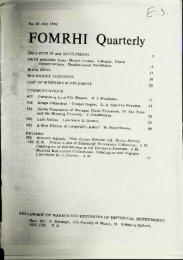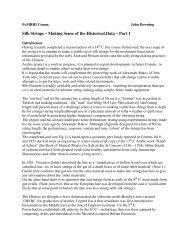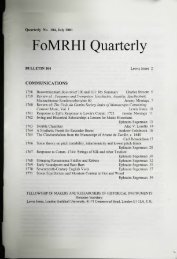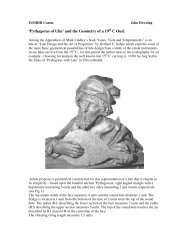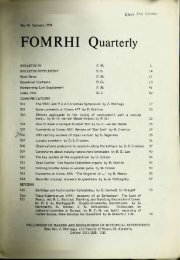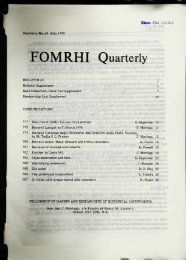• I f - FoMRHI
• I f - FoMRHI
• I f - FoMRHI
You also want an ePaper? Increase the reach of your titles
YUMPU automatically turns print PDFs into web optimized ePapers that Google loves.
36<br />
Comm. I 6 o s Gianf ranco Miscia & Marco Tiella<br />
Keyboard instruments building in Abruzzo (Central Italy)<br />
Gianfranco Miscia<br />
Keyboard instrument making of the 19th century in Lanciano (Abruzzo, Italy)<br />
Lanciano is the main town of the Frentana area in southern Abruzzo, which<br />
became a bishopric in 1515 and an archbishopric in 1562. The organ building<br />
tradition in Lanciano may date back to the 16th century, as the musical<br />
traditions of the town were already consolidated at that time. Among the most<br />
important musicians of Lanciano we must mention Ippolito Sabino, composer<br />
of madrigals in the 16th century, Fedele Fenaroli, teacher and composer in the<br />
18th century, and Francesco Masciangelo in thel9th century. This is the general<br />
context in which the keyboard instrument makers worked and about which we<br />
have information from reliable sources.<br />
Important data about organ builders born or working in Lanciano were<br />
collected by Corrado Marciani. From his studies we know that Andrea and<br />
Jacobo Vicentino came to Lanciano from Venice in 1542 and that they probably<br />
built the organ of the Annunciata church, which was then the cathedral 1 . It also<br />
appears from his work that Francesco Paolo Sabino, an organ builder born in<br />
Lanciano, in 1551 signed a contract in Vasto (not far from Lanciano) for the<br />
construction of an organ for the San Salvo church 2 . There is no doubt that the<br />
most important organ builder was Camillo Sabino, who built the organs of<br />
Santa Maria del Ponte and S. Francesco in Lanciano, of the cathedral of Ascoli<br />
Piceno in 1561, of the churches of S. Maria Maggiore in Ripatransone (1564-<br />
1565), of S. Pietro Martire in Ascoli (1569) 3 , of S. Agostino in Offida (1573) 4 , of<br />
the cathedral of Termoli and of the Chiesa Maggiore of Guglionesi (1574) 5 . The<br />
characteristics of these last two instruments are known from the contracts<br />
written in Lanciano. The organs had 45 keys, 9 stops 6 with "lo tremolante, lo<br />
tamburro, lo rosignolo seu l'uccellino" (tremulant, drums, nightingale or bird).<br />
A sum of 360 ducats was paid for these organs.<br />
We know that all through the 17th century the activity of the organ builders'<br />
family Sabino flourished, but information deriving from the 18th century is<br />
scarce, apart from the findings of Marciani. In Marciani's opinion the influence<br />
of the Neapolitan school of Felice Cimmino reached Lanciano, in contrast with<br />
the influence of the Venetian school to which all of the Sabino organ builders<br />
belonged 7 . Owing to the lack of documents it is impossible better to describe<br />
what happened in Lanciano during the 18th century. It is evident that<br />
somebody took care of the instruments, as the activity of the Cappella Musicale<br />
of the Santa Casa del Ponte church in this period was remarkably intense. In<br />
the 18th century the Cappella was directed by Francesco Antonio Fenaroli,





